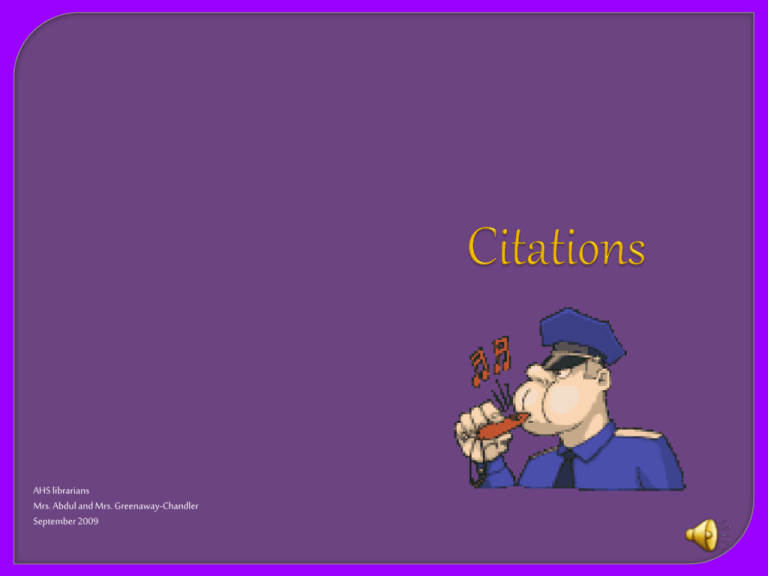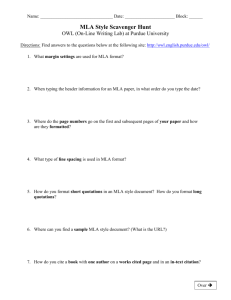Plagiarism and MLA Citations - Ector County Independent School
advertisement

AHS librarians Mrs. Abdul and Mrs. Greenaway-Chandler September 2009 Why do I have to cite sources in my research paper, anyway? Why do I have to use different citation styles? How do I know when to cite? What is the difference between a bibliography and works cited page? Who is going to help me if I can’t do it? Purpose for citing your sources •Academic Integrity •Authority •Prevents Plagiarism •Identify the sources used When to cite CITE Author’s idea Author’s thought Author’s opinion Author’s research Quotations Summary of someone’s work / research Other people’s pictures, illustrations, etc. DO NOT CITE Common knowledge Your idea Your thoughts Your opinion Your artwork/pictures Scenario 1 “A sociology teacher gave an in-class practice writing assignment to prepare her students for their blue-book midterm. After distributing copies of a magazine article, she asked students to take 45 minutes to write an essay responding to a question discussed in the article. Most of the students included information and/or quotations from the article, but few of those students actually mentioned the article or gave credit/citations” (“Identifying Plagiarism” 2). How would you address this problem? Scenario 2 “Stuart is really excited about his paper on the cultural connections between Jazz and Rap. Unfortunately, he hasn’t been able to start writing because each time he reads something new his focus changes. Stuart is starting to freak out and is tempted to just paste together some stuff off the website he’s found so he has something to hand in. You’re his friend, what do you tell him?” (“Starr”). In-text citation Pointing to where you got your information from (data, quotes, images, facts) inside the body of the text Bibliography • Complete list of every source you used for the assignment Works Cited • A list of all of the resources that were CITED in the assignment MLA stands for Modern Language Association. It is used in the humanities. APA stands for American Psychological Association. APA style is used in the social sciences. Turabian (Chicago) is used by historians and in the publishing industry because of its use of footnotes and endnotes. Council of Biology Editors (CBE) is used in the natural sciences. •Single Author •Multiple authors •No Author •Webpage In the body of your paper Leroy predicted in 1998 that eBay would become the most lucrative Internet business, surpassing most businesses even during tough economic times (45). Or, Founded in 1995 by Pierre Omidyar, Jeff Skoll and Meg Whitman, eBay has become the most lucrative Internet business (Leroy 45). In your works cited page Leroy, Jonathan G. eBay: Stunning Success. New York: Dover Publishing, 2001. A book with two or more authors According to Franklin and Moss, “Approximately a half-million African Americans saw service overseas during World War II” (440). A significant number of African Americans served in World War II (Franklin and Moss 440). In your works cited page Franklin, John Hope and Alfred A. Moss. From Slavery to Freedom. New York: McGraw-Hill, 1994. TIP: When there are two authors, cite both of them. Three or more, use et al. Write the first name and et al. follows. MLA In-text citation No Author associated with the magazine article The American Academy of Dermatology suggests using a sunscreen that protects against both UVA and UVB rays and has a SPF of at least 15 (“Shining the Light on Sunscreen” 21). The higher the number, the more your skin will be protected. In your works cited page “Shining the Light on Sunscreen.” A Brighter Society. 5 Dec. 1998:21. TIP: When the author is unknown, use the title of the book, article or organization. If the title is long, you can always shorten it. MLA In-text citation Using the entire webpage, not just a document The Harriet Tubman Home for the Aged is a National Historic Landmark. Today, it is owned and operated by the AME Zion Church (“Harriet Tubman Home for the Aged”). In your works cited page "Harriet Tubman Home for the Aged." NRHP Travel Itinerary. 1998. National Park Service. 13 Dec 2008 <http://www.nps.gov/history/nr/travel/pwwmh/ny13.htm>. TIP: If no author is available, then use the title of the webpage in quotes. Works Cited Page No author? Title comes next “Experimental psychology at private colleges.” New York Times. 15 Apr. 2002: A8. Johnston, Lawrence and Denise Smith. When the snow falls. Des Moines: Delacorte Press, 1998. Underline or italicize Always indent second line “The Flu.” Nine MSN. 2000. University of Minneapolis. 21 Oct. 2001. <http://news.ninemsn.com.au/health/story_13178.asp> Smiles, James. "libraries Work." School library Journal 2006: 12. Ebscohost. Ebscohost. Albany High School. 10 Dec 2008. <http://search.ebscohost.com/login.aspx?authtype=ip,uid >. Page 15 Page number Try to introduce your author, the work, or the date it was written • i.e. According to Thompson’s article, • i.e. In the article “The Right Way To Do Laundry,” • i.e. Published in 2007, Harry Potter and the Deathly Hallows was hands-down the best book of the 21st century. In-text citations allow you to find more information on the works cited page easily • Use author’s last name and page numbers. • Do not use “pp.” or “p.” or “pgs.” • If there’s no author, then use the article’s title. Try these tutorials: MLA Citation Game Test your MLA IQ In-text Citation - When to cite In-text Citations Exercises You Quote it, You note it! – A plagiarism exercise Tips for the Works Cited Page Citations should be in alphabetical order. If there’s no author, then use the article’s title. Underline the title of books and magazines. Citations should be double spaced. The second line and subsequent lines should be indented at least 5 spaces. The Works Cited Page should also be numbered. Always check with your teacher to determine which citation style you should use in your research paper Be consistent Rules may change for citations, but consistency is best Use college websites, handbooks, or Internet sources to stay updated http://www.ahs.albany.k12.ny.us/AHS/depts/library/index.html Knightcite Citation Machine BibMe Bibliography "Identifying Plagiarism Activity Sheet." Lehman College/College Now. 2002. Lehman College. 13 Dec 2008 <http://www.lehman.cuny.edu/provost/enrollmentmgmt/collegenow/plagiarism/module2.html> Cite a Source: How and Why You Should Do It. University of Illinois at Urbana-Champaign. 16 July 2008. YouTube. 9 December 2008. <http://www.youtube.com/watch?v=c5cRg2NG2WQ>. Delaney, Robert. "MLA Citation Style ." Long Island University B. Davis Schwartz Memorial library. 15 November 2007. Long Island University. 13 Dec 2008 <http://www.liu.edu/cwis/cwp/library/workshop/citmla.htm>. Harvey, Michael. "The Nuts and Bolts of College Writing." Nuts and Bolts of College Writing. 2003. Washington College. 13 Dec 2008 <http://nutsandbolts.washcoll.edu/mla.html#in-text>. "MLA Citation Examples." Honolulu Community College library. 20 September 2004. Honolulu Community College library. 13 Dec 2008 <http://honolulu.hawaii.edu/legacylib/mlahcc.html>. Starr, Karen. "Helpful Strategies: Scenarios." University at Albany. 2002. University at Albany. 13 Dec 2008 <http://library.albany.edu/usered/plagiarism/page6.html>. "What is MLA Style?." Modern Language Association. 29 April 2008. Washington College. 12 December 2008 <http://www.mla.org/style>.







